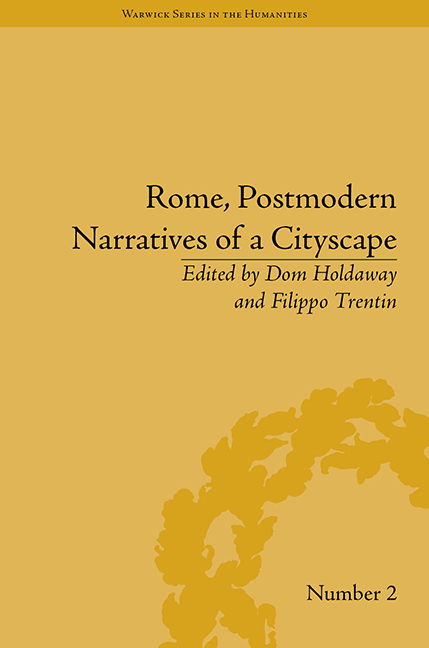Book contents
- Frontmatter
- Contents
- Acknowledgements
- List of Contributors
- List of Figures
- Introduction: Rome, Postmodern Narratives of a Cityscape
- Part I Knowing Rome
- 1 Between Rome's Walls: Notes on the Role and Reception of the Aurelian Walls
- 2 The Explosion of Rome in the Fragments of a Postmodern Iconography: Federico Fellini and the Forma Urbis
- 3 Centre, Hinterland and the Articulation of ‘Romanness’ in Recent Italian Film
- Part II Fragmented Topography
- Part III Situating Rome
- Notes
- Index
3 - Centre, Hinterland and the Articulation of ‘Romanness’ in Recent Italian Film
from Part I - Knowing Rome
- Frontmatter
- Contents
- Acknowledgements
- List of Contributors
- List of Figures
- Introduction: Rome, Postmodern Narratives of a Cityscape
- Part I Knowing Rome
- 1 Between Rome's Walls: Notes on the Role and Reception of the Aurelian Walls
- 2 The Explosion of Rome in the Fragments of a Postmodern Iconography: Federico Fellini and the Forma Urbis
- 3 Centre, Hinterland and the Articulation of ‘Romanness’ in Recent Italian Film
- Part II Fragmented Topography
- Part III Situating Rome
- Notes
- Index
Summary
Introduction
This chapter describes some aspects of the suburban expansion of the city of Rome with particular attention to the typical emphasis that has anchored its critical discussion to a rigid model of centre and periphery. A division between Rome and its edges has been in place since antiquity, but the differentiation became increasingly significant in the period after 1870, the siting of the national capital, and the beginning of the historic city's transformation from a town of some 200,000 inhabitants to the largest Italian comune (municipality), with a population today of more than 2.5 million. I make use of cinematic examples Caro diario (Dear Diary, Nanni Moretti, 1993) Velocità massima (Maximum Velocity, Daniele Vicari, 2002), Romanzo criminale (Crime Story, Michele Placido, 2005) to describe the specificity of present-day Rome and the search for representations that address its contemporary spatial complexity.
Past and Present
Rome exhibits traces of two millennia of settlement that remain visible in its palimpsestic, vertical ordering of successive pasts. In constructing the ancient city and then in elaborating the papal city, these pasts have consistently exploited the occupation and re-occupation of space (the Pantheon), the use and reuse of materials (St Peter's Basilica) or the borrowing of forms (the Baptistery of St John Lateran).
- Type
- Chapter
- Information
- Rome, Postmodern Narratives of a Cityscape , pp. 57 - 78Publisher: Pickering & ChattoFirst published in: 2014

